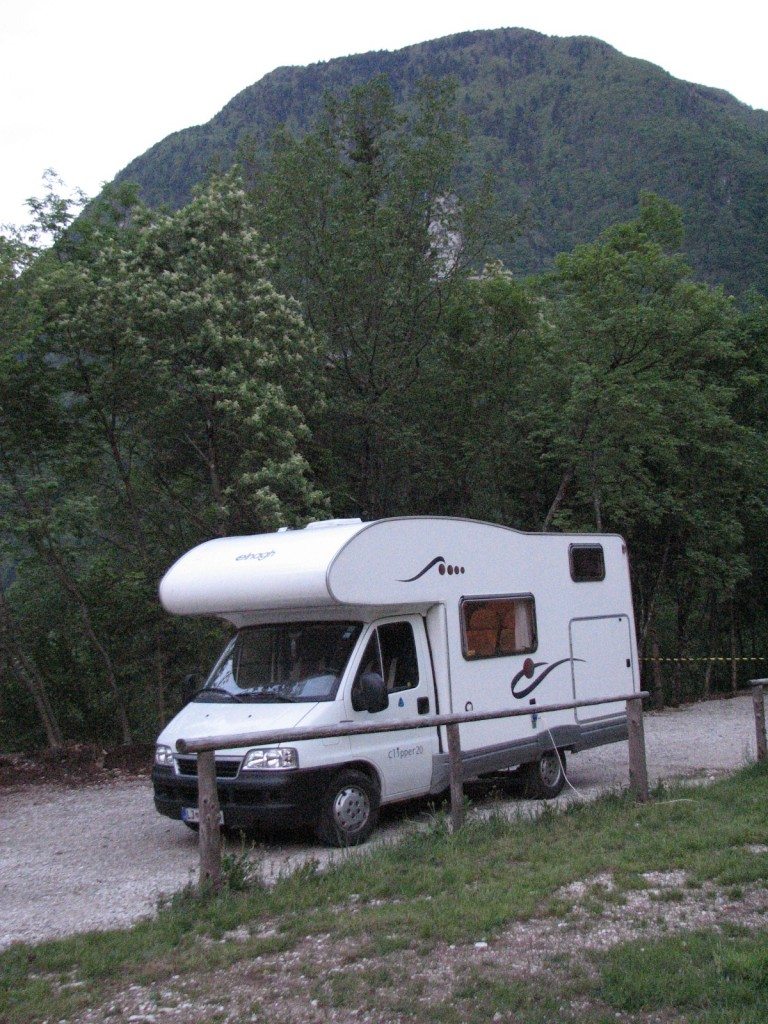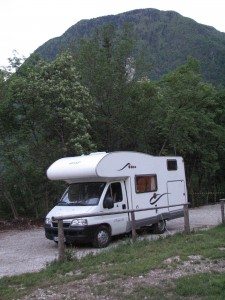 To celebrate the fall of the ghost, or more specifically the school holiday associated with Pentecost, we decided to travel to Slovenia to gather information for our book about travelling with kids. We chose Slovenia because Ashley saw some pictures of mountain rivers with shimmering blue-green water and deep caves with colourfully lit stalactites, and there was no convincing her that there was any better place to take a little vacation. And since these destinations are decidedly un-urban and its springtime, we decided to try renting a camper van to have greater mobility than buses and trains allow while getting us closer to nature.
To celebrate the fall of the ghost, or more specifically the school holiday associated with Pentecost, we decided to travel to Slovenia to gather information for our book about travelling with kids. We chose Slovenia because Ashley saw some pictures of mountain rivers with shimmering blue-green water and deep caves with colourfully lit stalactites, and there was no convincing her that there was any better place to take a little vacation. And since these destinations are decidedly un-urban and its springtime, we decided to try renting a camper van to have greater mobility than buses and trains allow while getting us closer to nature.
I had been to Ljubljana back when it was a Yugoslavian provincial
capital, but I don’t remember anything about the Slovenian capital of 290,000 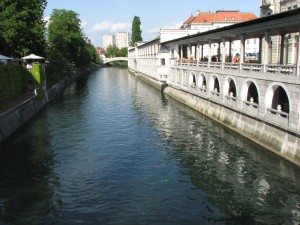 people. The walk from the train station to the hostel, after the six-hour ride from Vienna last Friday, didn’t ring any bells either. The outdoor cafes along the river in the old town, just below the castle on the hill, were the perfect place to recover from the journey and enjoy ice cream and beer (separately) in the afternoon sun. It’s been awhile since I stayed at a hostel, and though we had a private room with four beds, the noise from the communal room outside our door made sleeping a little challenging until folks either went to bed or headed out into the night.
people. The walk from the train station to the hostel, after the six-hour ride from Vienna last Friday, didn’t ring any bells either. The outdoor cafes along the river in the old town, just below the castle on the hill, were the perfect place to recover from the journey and enjoy ice cream and beer (separately) in the afternoon sun. It’s been awhile since I stayed at a hostel, and though we had a private room with four beds, the noise from the communal room outside our door made sleeping a little challenging until folks either went to bed or headed out into the night.
The owner of the camper that Ashley found on the internet brought it by the hostel on Saturday morning. After a run-through of camper operation, including an English-language GPS, we set off south looking for a cave. I’ve never driven a camper and it’s been years since I’ve driven anything bigger than a pick-up truck. My European driving experience is less than two days in a friend’s car in a rural Austrian valley, so I was a little ambivalent about driving a whale on the tight continental roads. But with directions from the GPS, whom we named Bridgette because of her sexy British accent, driving was a piece of cake. The highways in Slovenia are relatively new, though you have to watch the rear-view mirrors going through the toll booths, and the camper was small enough to make driving on the windy country roads actually kinda’ fun. It was license to drive them at a normal pace, instead of at the break-neck Formula One speed that the sports cars and motorcycles use.
After about an hour and less than 10 km from the Italian border, we pulled into the parking lot for the Skocjan caves, a UNESCO World Heritage Site. Admission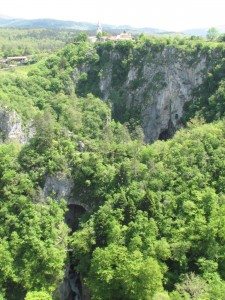 is only by guided tour, and the entrance tunnel has me worried that I may have inherited my father’s claustrophobia. But it soon opens out into a big room filled with the aforementioned stalactites and stalagmites. Slovenia is famous for caves because the region is dominated by karst geology, which is made up of water-soluble bedrock like limestone. Instead of rain water running off the land into surface creeks and rivers, it percolates down through the rock, collecting in subsurface rivers and emerging in valleys as freshwater springs. As the water erodes the rock, it leaves behind these awesome caves, which can be dozens of km long and multileveled as the river sinks ever deeper over time.
is only by guided tour, and the entrance tunnel has me worried that I may have inherited my father’s claustrophobia. But it soon opens out into a big room filled with the aforementioned stalactites and stalagmites. Slovenia is famous for caves because the region is dominated by karst geology, which is made up of water-soluble bedrock like limestone. Instead of rain water running off the land into surface creeks and rivers, it percolates down through the rock, collecting in subsurface rivers and emerging in valleys as freshwater springs. As the water erodes the rock, it leaves behind these awesome caves, which can be dozens of km long and multileveled as the river sinks ever deeper over time.
The first few rooms of the cave are interesting because of the rock formations (stalactites grow about one cm in a century), the cool lighting, and we realize that 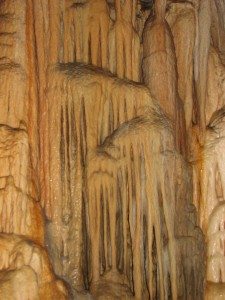 we are underground. As we walk deeper into the cave along a paved path the rooms get larger and more breathtaking. Eventually we can hear the roar of moving water and enter an enormous room where a river emerges from a hole in one wall and snakes its way along. The path is carved into the rock high up on the cave wall, and we look in awe over the handrail at the water below. We’re definitely the slowest people on the tour, having started near the front of the pack, but eventually bringing up the rear, making conversation with the guide who is making sure no one is left behind. She turns off the lights behind us as we go, giving us the dark lonely feeling that maintains the rarity of active spelunkers.
we are underground. As we walk deeper into the cave along a paved path the rooms get larger and more breathtaking. Eventually we can hear the roar of moving water and enter an enormous room where a river emerges from a hole in one wall and snakes its way along. The path is carved into the rock high up on the cave wall, and we look in awe over the handrail at the water below. We’re definitely the slowest people on the tour, having started near the front of the pack, but eventually bringing up the rear, making conversation with the guide who is making sure no one is left behind. She turns off the lights behind us as we go, giving us the dark lonely feeling that maintains the rarity of active spelunkers.
We follow the river until we can finally see sunlight, and we emerge through a giant cave opening into a deep forested canyon. The river emerges into the same valley through a separate cave opening dozens of meters below, but disappears again into the ground after only 100 meters or so in daylight. We ride a funicular to the parking lot at the rim.
About 10 km away from the Skocjan caves is Lipica, where the Hapsburg Kaiser established a Lipizzaner horse farm in the late 1500s. Since we can’t afford the 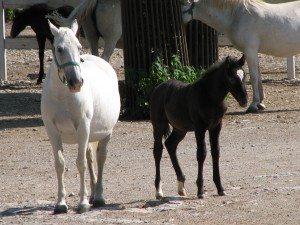 Lipizzaner shows in Vienna, we figured we’d check it out, but we find that there are no shows on Saturday afternoons. We take photos of the white mares and their black foals in their grassless paddocks and head for the campground.
Lipizzaner shows in Vienna, we figured we’d check it out, but we find that there are no shows on Saturday afternoons. We take photos of the white mares and their black foals in their grassless paddocks and head for the campground.
We had arranged to meet our friends from Germany (the same friends we met in Salzburg) at a campground near the Postojna cave, about 30 km northeast of the 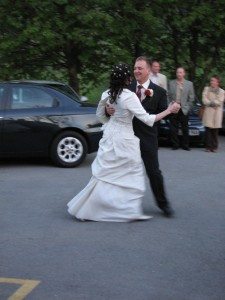 Skocjan cave. Unfortunately, the campground pool doesn’t open until June 1st, so instead we head into town to find a restaurant. The place we find is out of the way and almost empty, but they are hosting a wedding reception later in the evening. We enjoy our dinner as the accordion-tuba polka band warm up in the next room, and leave as the happy couple have their first dance out in the parking lot.
Skocjan cave. Unfortunately, the campground pool doesn’t open until June 1st, so instead we head into town to find a restaurant. The place we find is out of the way and almost empty, but they are hosting a wedding reception later in the evening. We enjoy our dinner as the accordion-tuba polka band warm up in the next room, and leave as the happy couple have their first dance out in the parking lot.
Our first night in the camper is a little claustrophobic, with Ashley and I in the bed above the cab and the girls in separate bunks in the back. I hesitate to use the gas heater and its pretty cold in the morning, but the sun warms us quickly. The camper may be easier than a tent in that you don’t have to set it up, but you still have to put everything away before you can go anywhere.
With our friends we go the Postojna cave, a completely different experience than the Skocjan cave. It’s the most visited attraction in the country and has an associated hotel, half a dozen restaurants, and twenty tour buses in the parking lot. We take a fast little train for two km underground before we get out to walk. There are some spectacular rooms, but the underground river is in another cave 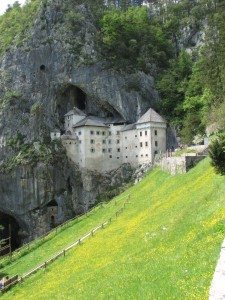 several dozen meters below us. We’re happy to leave the spectacle behind and drive 10 km up the road to Predjama Castle, built over 700 years ago into a cliff face and at the mouth of yet another cave. That way, the robber baron knight that built it could either defend himself or escape into the earth.
several dozen meters below us. We’re happy to leave the spectacle behind and drive 10 km up the road to Predjama Castle, built over 700 years ago into a cliff face and at the mouth of yet another cave. That way, the robber baron knight that built it could either defend himself or escape into the earth.
Being sated on the cave front, we say goodbye to our friends and head about 110 km northwest to the town of Bovec in the Soca valley. The Soca River has the blue-green water that inspired the trip, and it’s caused by the minerals eroding from the karstic limestone. Bovec is a nature lover’s paradise, being a small town surrounded by steep snow-capped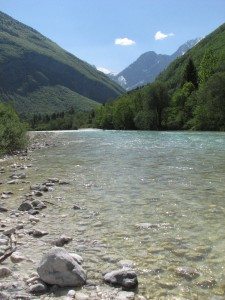 mountains, and of course the river. In town there are countless businesses offering white water rafting, kayaking lessons, mountain biking, canyoneering, paragliding, and mountain climbing. There’s a now-dormant ski lift at the south end of town and the local camp ground is literally wall-to-wall kayakers. We feel lucky to find a spot to park the camper and still be able to hear the river.
mountains, and of course the river. In town there are countless businesses offering white water rafting, kayaking lessons, mountain biking, canyoneering, paragliding, and mountain climbing. There’s a now-dormant ski lift at the south end of town and the local camp ground is literally wall-to-wall kayakers. We feel lucky to find a spot to park the camper and still be able to hear the river.
Of course, one of the first things that Ashley does is to see if she can get on a commercial rafting trip. So for the first time ever the next day, with Z and L and I playing on a cobble bar at the river’s edge, Ashley pays to be guided down a river. I know that she has fun, but she doesn’t like being a passenger when she’s used to driving.
After she changes her wet clothes, we head for the pass out of the valley that leads to Italy. There is another pass that stays within Slovenia, but everyone we ask says that it won’t be fun in the camper. It was built during WWI by Russian prisoners and has something like 126 switchbacks. Buses take tourists over the pass so it can’t be that bad, but the road through Italy is only half-an-hour longer and has only four switchbacks so we opt for the more prudent option. We’re only supposed to be in Italy for 15 km before turning back into Slovenia, but Bridgette mistakenly diverts us eight km onto a road to Austria. When she tries to correct her mistake, she puts us on a highway back to Italy, where we promptly get pulled over for not having a valid highway permit. I’m sure the compassionate Italian policeman didn’t understand my explanation that included an inanimate object named Bridgette, but he let us go without paying the €120 fine. We quickly and thankfully got back on the right road back to Slovenia.
On our last night we slept in a campground in Dovje, looking south at the mountains we were looking at to the north of Bovec. The girls played in a 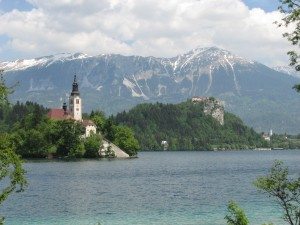 meadow as the sun went down. In the morning we made for Bled, which one of the river guides said was filled with old people. Sure enough, the church on the small island in the middle of a mountain lake, with a castle on the rocky shore, is a major destination for the bus touring crowd. It’s a beautiful place to watch the sun set. We have pastries in a lakefront café and take a horse-drawn carriage around the lake as our last day in Slovenia hurrah.
meadow as the sun went down. In the morning we made for Bled, which one of the river guides said was filled with old people. Sure enough, the church on the small island in the middle of a mountain lake, with a castle on the rocky shore, is a major destination for the bus touring crowd. It’s a beautiful place to watch the sun set. We have pastries in a lakefront café and take a horse-drawn carriage around the lake as our last day in Slovenia hurrah.
An hour later we’re at the campground in Ljubljana, cleaning the camper and returning it back to the owner. Filling the gas tank costs about €70, which is a deal since gas in Slovenia is 80% of what it costs in Germany (roughly $7/gallon vs. $8.70). We’ve covered fully a third of the country in four days, and the train takes us through the middle of the rest. It’s surprisingly rolling topography only gives way to flat agricultural land near the Austrian border. We’d like to come back with a smaller car and a tent to get to even more remote areas of the mountains, or maybe in the winter during ski season. But the camper experiment is definitely a success.

